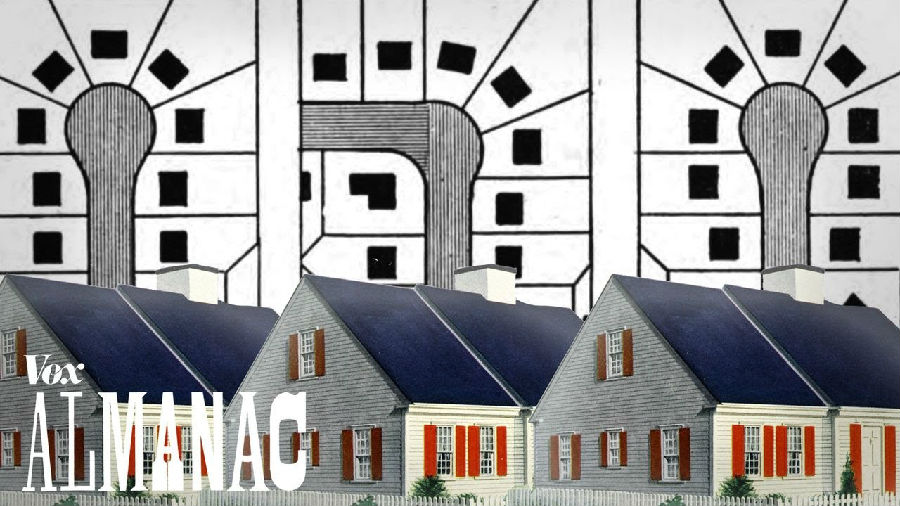But developers would be taking a huge risk to ignore the FHA, since these loans sold houses.
但忽视住房管理局的标准开发商将要承担巨大的风险,因为这些住房都是按揭的。
Somewhere in the middle of the spectrum, the FHA’s recommendations also included city planning.
联邦住房管理局的建议范围还包括城市规划。
They started with car-friendly minimum street widths and then expanded.
他们最早提出的城市规划建议就是设置汽车友好型道路的最小宽度,在最小宽度的基础上扩宽。
In bulletins like “Planning Profitable Neighborhoods,”
他们还在“规划盈利社区”等公告中
the FHA laid out “ideal” suburban plans which were clearly labeled bad or good.
给出了“理想的”郊区规划,每种规划都清楚地标明了好坏。
They drew from models like Radburn, but focused on the car and left out the pedestrians.
他们借鉴了拉德伯恩等模范社区的设计,但将关注重点放在了汽车身上,继而忽略了行人的需求。
Grid plans were definitively “bad.”
网格式的布局肯定是“不好的”布局。
Other plans — with curvilinear, or winding, roads — were good.
其他样式的布局——有曲线或弯曲的道路的布局——就是好的布局。
That included cul de sacs.
尽端路设计就属于第二类。
This FHA-labeled “bad” plan shows why curved streets really did make sense sometimes.
这个被住房管理局贴上了“不好”标签的规划就说明了弯曲的街道之所以合理的原因。
The dotted lines show topography — like hills.
虚线展示的是社区的地貌——山丘什么的。
A grid plan would have required a ton of construction to work around the landscape.
网格式布局社区景观建设方面的工作量会非常大。
The good plan — a curvilinear one — reduces construction costs and is just nicer to look at.
而好的布局——曲线型的布局——就能够减少建筑成本,看起来也会更美观。
But these plans also insisted on a car-centered vision of the neighborhood,
不过,这类布局要求社区围绕汽车进行设计,
with cul de sacs designed to slow down vehicles and limit through traffic —
尽端路设计的初衷就是减慢车辆行驶的速度,限制车流量——
while also guaranteeing that cars were necessary to get around.

This bad plan would have worked well for public transportation and city services, or a walking commute.
就公共交通,城市服务和步行上下班而言,这个不好的方案其实也不错。
But developers couldn’t risk bad plans.
问题是,开发商不能拿不好的方案试水。
The “good” plan was the only safe option if they wanted their houses to sell.
他们要想把房产卖出去,“好”方案是唯一安全的选择。
Plans drafted the “bad way” were revised to fit the FHA’s vision of the good life.
于是,开放商照着满足住房管理局设立的美好生活的愿景的标准修改了那些按照“不好”的布局起草的方案。
That was a combination of financial coercion and a quickly evolving sense of what a suburb “should be.”
这就是财政强制和快速变化的郊区“应该是什么样”这一观念相融合的体现。
Listen, I played kickball in cul de sacs.
跟你们讲,我在采用尽端路设计的社区里兜了好多圈。
They have a lot of advantages.
这类社区确实有很多优势。
They really do slow down through traffic, they create a sense of community, they just have a lot of things going for them.
他们真的做到了减速慢行,也营造出了社区的感觉,确实是有很多可圈可点的地方。
And this subdivision here doesn’t have much to do with those outmoded FHA guidelines,
尽管我现在所在的这个社区的设计和住房管理局那些早已过时的规定已经没太大联系了,
but it does exist in a culture that those guidelines created.
但它确实受到了那些规定所塑造的文化的影响。
The cul de sac — it crowded out a million other good ideas.
他们采用的尽端路设计——淘汰掉了无数个其他的好主意。
Ideas that could have had a different vision of the suburbs.
那些主意原本可能对郊区的规划有着不同的设想。
Ideas that weren’t all about - this.
对这玩意儿(汽车)的关注也没有那么高。
Today, some suburbs are changing the plan.
如今,有一些郊区已经开始改变他们的规划了。
There’s even a way to make existing cul de sacs more walkable.
甚至还出现了让现有的尽端路设计更适合步行的办法。
But it’s a little strange that so many places are still beholden to the old FHA’s vision of the one good life.
但有点奇怪的是,还是有好多好多地方依然守着住房管理局过去那一套美好生活的愿景。
This is a proposed black subdivision near Atlanta, from a 1948 FHA plan.
这是1948年联邦住房管理局在亚特兰大附近拟规划的一个黑人居住区。
The plan included a “planting strip” to serve as a visible boundary between white and black neighborhoods.
这个方案设计了一个“种植带”,作为白人社区和黑人社区的界线。
In the same plan, the FHA plotted very elegant curvilinear streets and cul de sacs.
与此同时,住宅管理局又在这一方案中规划了非常漂亮的曲线街道和尽端路。


